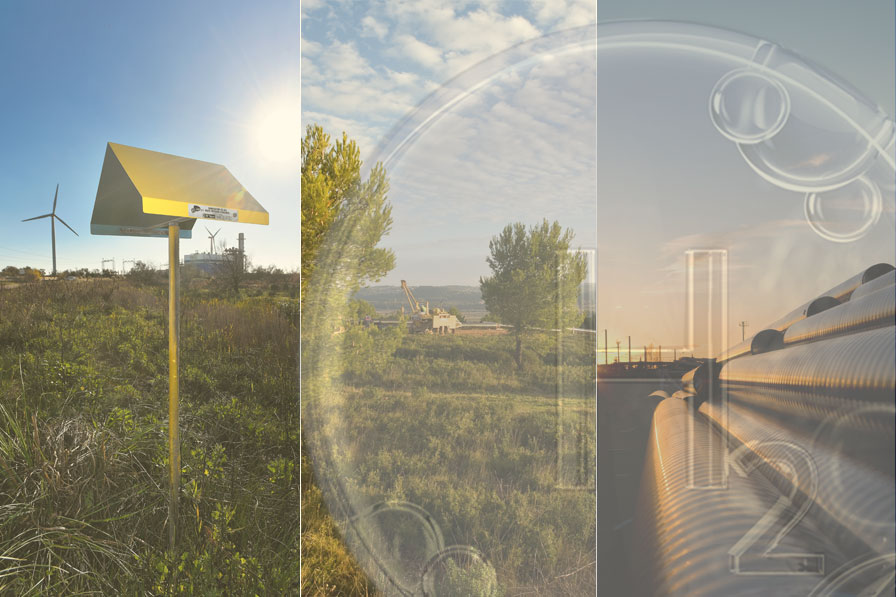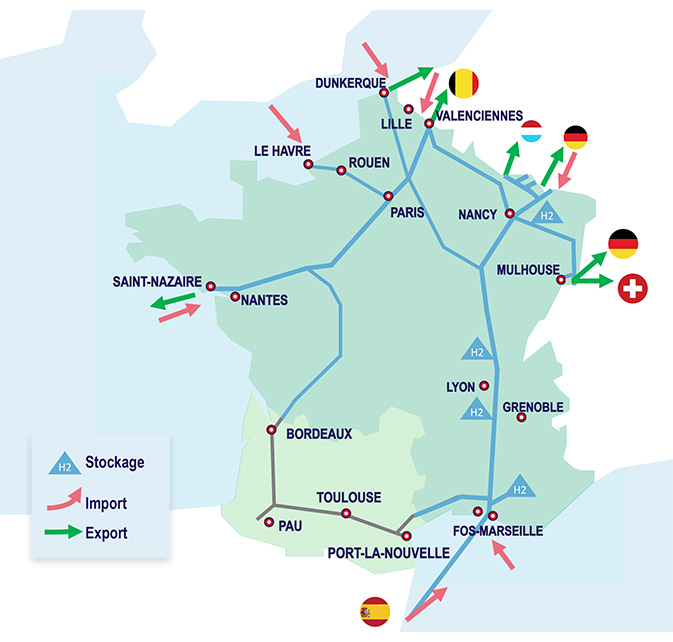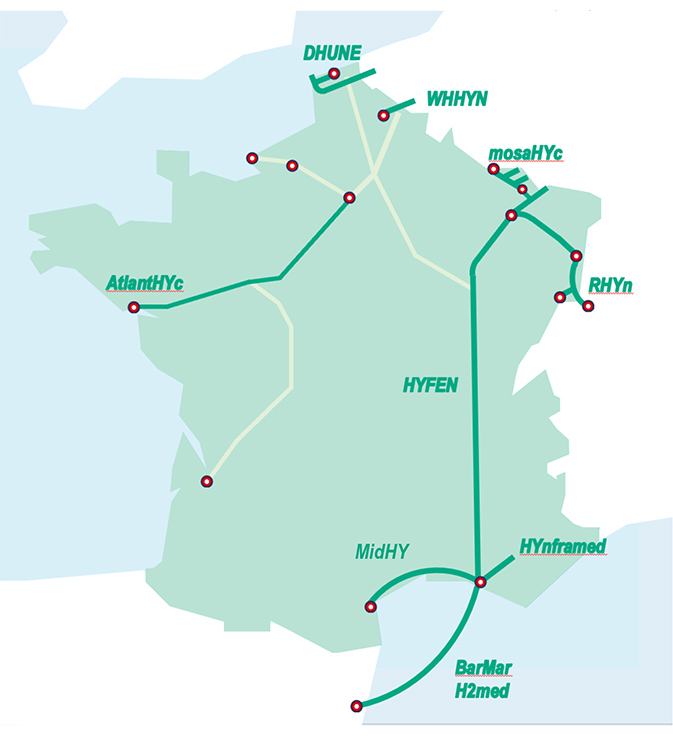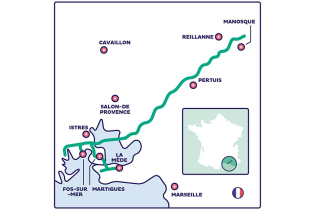Transportation of hydrogen

GRTgaz is supporting the development of low-carbon and renewable hydrogen by designing future hydrogen transportation infrastructures and helping to create a single, open and accessible market at local, national and European level.
Developing hydrogen transportation networks in France and Europe
Industrial hubs and progressive territorial coverage
GRTgaz is preparing to develop an open hydrogen transportation network, either by converting existing gas pipelines or by building new infrastructures.
The hydrogen development strategy has three main strands:
- Develop open-access hydrogen transportation networks in France’s main industrial regions: these high-CO2-emitting areas combine a substantial need for decarbonisation with a high demand for energy and capacities to produce low-carbon hydrogen. The creation of local hydrogen transportation infrastructures provides a link between producers and consumers in a regional context. It guarantees the security and flexibility of supply while offering a high-performance, local solution for decarbonising industrial uses.
- Gradually serve the entire country by connecting industrial regions together and linking up production and consumption areas to hydrogen storage facilities.
- Work to develop European interconnections by organising and steering cross-border initiatives and the H2MED European corridor project. The ultimate aim is to contribute to the creation of a competitive and accessible single European hydrogen market through the construction of transportation infrastructures.
“The future of hydrogen and the decarbonisation of its uses depend, to a large extent, on the price of hydrogen and consumer confidence in the security of supply. The latter presupposes a hydrogen transportation infrastructure that is available, reliable and robust enough to meet customers' needs. Driven by this conviction, GRTgaz is working on the development of local, national and cross-border transportation networks that are efficient, dedicated to hydrogen and accessible to all.”Jana Kavicka
H2 Business Developer
GRTgaz’s hydrogen infrastructure projects
With this in mind, GRTgaz is working on numerous projects with local and cross-border hydrogen stakeholders (consumers, producers, local and regional authorities, transport operators, etc.). By 2030, the first regional hydrogen transportation networks will be brought into service around the industrial centres that will be the future consumers of hydrogen.
List of projects for regional and cross-border hydrogen hubs in industrial regions:
- MosaHYc: a cross-border hydrogen network project involving the conversion of existing gas pipelines, linking the industrial regions of France, Germany and Luxembourg: the “Grande Région Hydrogène” (GRH).
- RHYn: a project aiming to develop the first hydrogen network in the Upper Rhine region by connecting the Mulhouse industrial agglomeration with the German hydrogen network.
- Franco-Belgian corridor: project to develop a large-scale cross-border network from the port of Dunkirk across the entire Franco-Belgian border region.
- WHHYN: the first cross-border hydrogen transport network between France and Belgium.
- DHUNE: a hydrogen infrastructure project in the Dunkirk industrial zone, with an extension to Belgium planned.
- HYnframed: a hydrogen network project in Fos-sur-Mer, connected to the Manosque storage facility, to ensure a secure supply for local manufacturers.
- HY-FEN: a hydrogen network project running from the South of France to the German border. It forms part of the H2MED corridor.
European corridor project:
H2med : project for a large-scale renewable hydrogen corridor in Europe, with the first BarMar element linking Barcelona and Marseille. H2med will be one of several large-scale European hydrogen transportation corridors linking southern and central Europe.
>> H2med project website
GRTgaz H2 under study

H2 infrastructure projects in development

>>> Télécharger les cartes (Réseau H2 à l’étude et projets en développement)
Les grandes étapes d’un projet d’infrastructure de transport d’hydrogène
Entre le moment où apparaît l’opportunité de bâtir une infrastructure de transport d’hydrogène et le début de sa construction, il peut s’écouler plus de quatre ans. Cette période est rythmée par différentes phases, dont quatre niveaux d’études préalables :
- Les études d’opportunité, appelées aussi études de pré-faisabilité. Ce diagnostic général effectué sur cartographie autour d’un tracé indicatif permet d’esquisser un périmètre technique et réglementaire, ainsi qu’une première estimation de planning et de chiffrage économique du projet.
Ces études débouchent sur l’appel à manifestation d’intérêt (AMI, ou Open Season), organisé afin d’identifier les acteurs économiques, potentiels producteurs d’hydrogène comme industriels consommateurs, intéressés par le projet d’infrastructure. - Les études de faisabilité, appelées aussi parfois pré-FEED. Menées sur un périmètre affiné grâce aux résultats de l’AMI, ces études permettent de préciser tous les aspects du projet :
scénarios de développement, tracé et dimensionnement du futur réseau, contraintes environnementales et mesures de minimisation des impacts, sécurité industrielle et contexte réglementaire et administratif. Le chiffrage et le planning de mise en œuvre deviennent plus précis. - Les études d’ingénierie de base, appelées aussi FEED (Front-End Engineering Design). Encore plus poussées que les dernières, elles sont nécessaires pour constituer le dossier administratif, lequel permet de déposer la demande d’autorisation de construire et d’exploiter, ainsi que l’éventuelle déclaration d’utilité publique (DUP).
Pour les clients ayant exprimé un intérêt pour le projet, elles aboutissent par ailleurs sur une offre tarifaire engageante. Une fois l’engagement contractuel obtenu, GRTgaz peut prendre la décision d’investissement. - Les études d’ingénierie détaillée. Les plans, le planning et les coûts du chantier à venir sont finalisés. Les équipes de GRTgaz mènent les appels d’offre pour les achats et les prestations de construction. En parallèle, les services de l’Etat instruisent la demande d’autorisation de construire et d’exploiter.
- La construction. Cette phase peut débuter dès la réception de l’autorisation de construire et d’exploiter : cela signifie que GRTgaz est tenu de construire tel qu’autorisé par l’administration française. A la fin du chantier, les équipes sur place procèdent à des essais techniques, puis préparent la mise en gaz. La mise en service et l’exploitation peuvent débuter.
Developing the hydrogen market in France
GRTgaz is participating in the development of the hydrogen market through consultations and calls for projects, aimed at identifying the potential for production and consumption.
- Low-carbon and renewable hydrogen market stakeholders’ consultation: carried out in 2021 and 2022, this participatory process launched by GRTgaz enabled us to better identify the needs of future hydrogen producers and consumers, particularly in terms of logistics and transport. To take this process one step further, in 2022, GRTgaz initiated regional workshops in France’s major industrial regions, confirming the strong local dynamics.
Consultation and dialogue with market stakeholders
Hydrogen network projects

